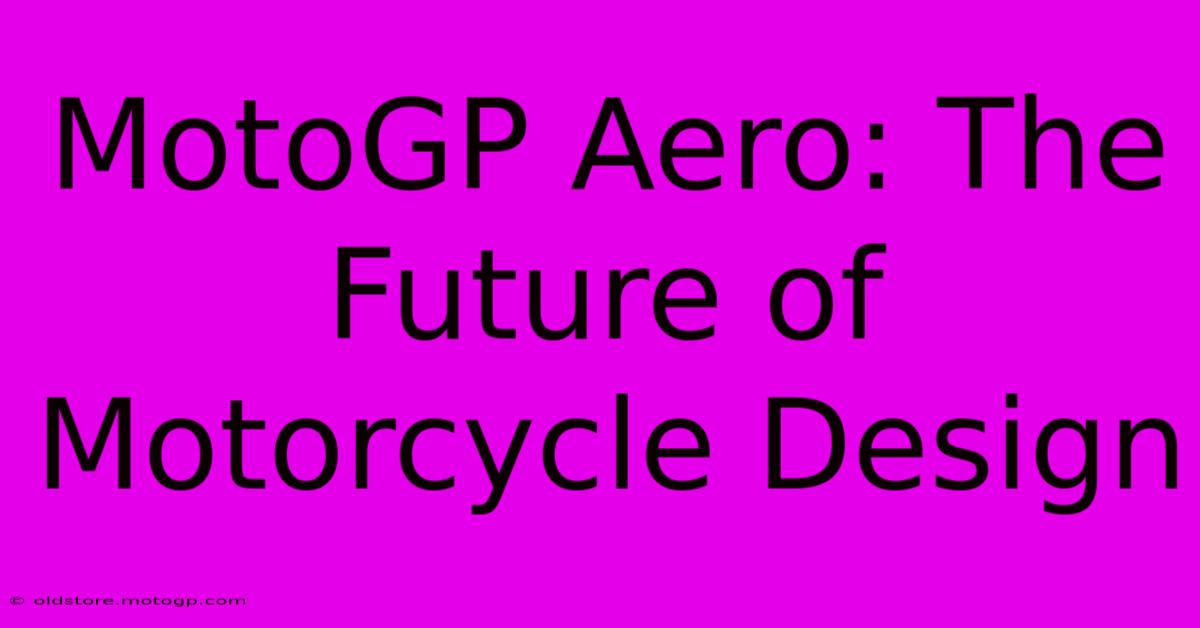MotoGP Aero: The Future Of Motorcycle Design

Table of Contents
MotoGP Aero: The Future of Motorcycle Design
The roar of the engines, the smell of burning rubber, the breathtaking speeds – MotoGP is a spectacle of skill and technology. But beyond the rider's prowess lies a constant battle for aerodynamic advantage, a quest that's pushing the boundaries of motorcycle design and shaping the future of the sport. This article delves into the crucial role of aerodynamics in MotoGP, exploring its current impact and predicting its future evolution.
The Current State of MotoGP Aerodynamics
Modern MotoGP bikes are not just fast; they're meticulously sculpted to cheat the wind. Aerodynamics are no longer a secondary consideration; they are a primary weapon in the fight for milliseconds. Teams employ sophisticated Computational Fluid Dynamics (CFD) simulations and wind tunnel testing to optimize every surface, every angle, every appendage.
Key Aerodynamic Features:
- Wings: These are arguably the most visible manifestation of MotoGP aero. These aren't just for show; they generate downforce, keeping the front wheel planted at high speeds and improving stability through corners. The design, angle, and number of wings are subject to constant refinement.
- Fairings: The entire fairing is designed to minimize drag and manage airflow around the rider and machine. Every curve and surface is carefully considered to optimize airflow and reduce turbulence.
- Bodywork: From the shape of the fuel tank to the tail section, every component plays a role in managing airflow and generating downforce. Even small changes can have a significant impact on performance.
- Underbody Aerodynamics: While less visible, the underbody is crucial. Sophisticated designs manage airflow beneath the bike, creating a ground effect that further enhances downforce.
The Impact of Aerodynamics on Racing
The impact of advanced aerodynamics in MotoGP is multifaceted:
- Increased Cornering Speeds: The enhanced downforce allows riders to carry significantly higher speeds through corners, shaving precious seconds off lap times.
- Improved Stability: Better aerodynamic balance translates to greater stability at high speeds, leading to improved rider confidence and reduced risk of crashes.
- Reduced Drag: Optimizing airflow reduces drag, allowing for higher top speeds on straights.
- Enhanced Overtaking Opportunities: The combination of increased cornering speed and reduced drag can create significant overtaking advantages.
The Future of MotoGP Aero: Innovation and Regulation
The pursuit of aerodynamic advantage is an ongoing arms race. What will the future hold?
Emerging Trends:
- More Sophisticated Simulations: CFD technology is constantly evolving, enabling ever more precise simulations and optimization of aerodynamic components.
- Active Aerodynamics: We might see the introduction of active aerodynamic elements that adjust in real-time based on speed, cornering forces, and other factors. Imagine wings that automatically adjust their angle depending on the track section!
- Biomimicry: Studying the aerodynamic properties of natural forms could inspire novel designs for MotoGP bikes.
- Material Science Advancements: Lighter, stronger, and more aerodynamically efficient materials will continue to play a significant role.
The Role of Regulation:
The governing body, the FIM, plays a critical role in regulating aerodynamic development to ensure fair competition and rider safety. Restrictions on wing size and shape are already in place, and these regulations are likely to evolve as technology advances. The challenge lies in balancing innovation with safety and maintaining a level playing field.
Conclusion: A Constant Evolution
MotoGP aerodynamics are a constantly evolving field. The pursuit of ever-greater performance drives innovation, pushing the boundaries of motorcycle design and creating a spectacle of both engineering brilliance and breathtaking skill. While regulations will continue to shape the landscape, the future of MotoGP will undoubtedly be defined, in part, by the ongoing quest for aerodynamic perfection. The quest for that elusive aerodynamic edge will continue to define the sport for years to come. The future of MotoGP is fast, and it’s aerodynamic.

Thank you for visiting our website wich cover about MotoGP Aero: The Future Of Motorcycle Design. We hope the information provided has been useful to you. Feel free to contact us if you have any questions or need further assistance. See you next time and dont miss to bookmark.
Featured Posts
-
The Future Is Fast Moto Gp Engine Technology That Will Define The Next Generation
Feb 24, 2025
-
Moto Gp Arcade Game The Next Level Of Arcade Racing
Feb 24, 2025
-
Invest In Your Safety Choose A Moto Gp Helmet
Feb 24, 2025
-
Get Closer To The Action With Moto Gp Announcers
Feb 24, 2025
-
Moto Gp Arcade Step Into The World Of Moto Gp
Feb 24, 2025
